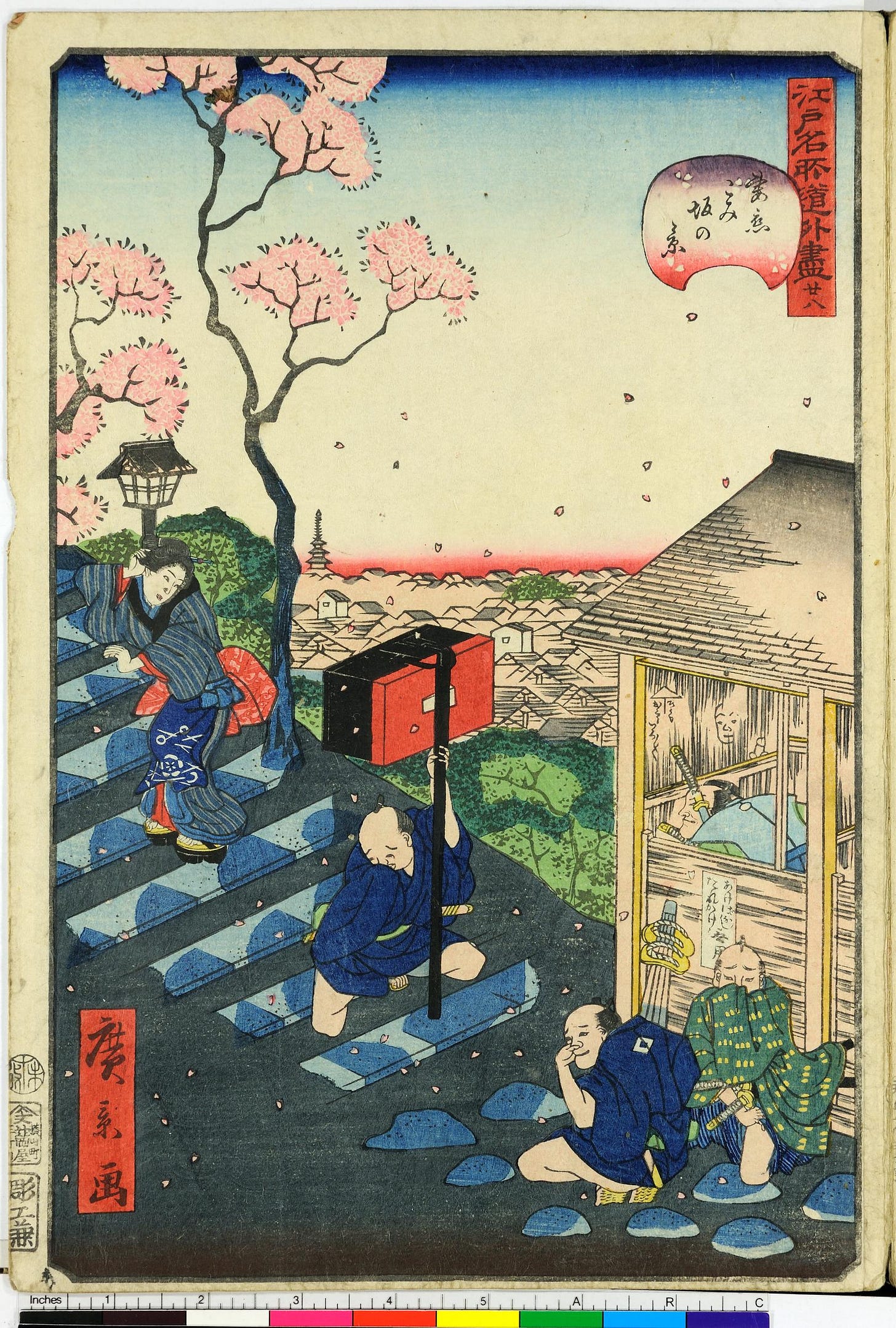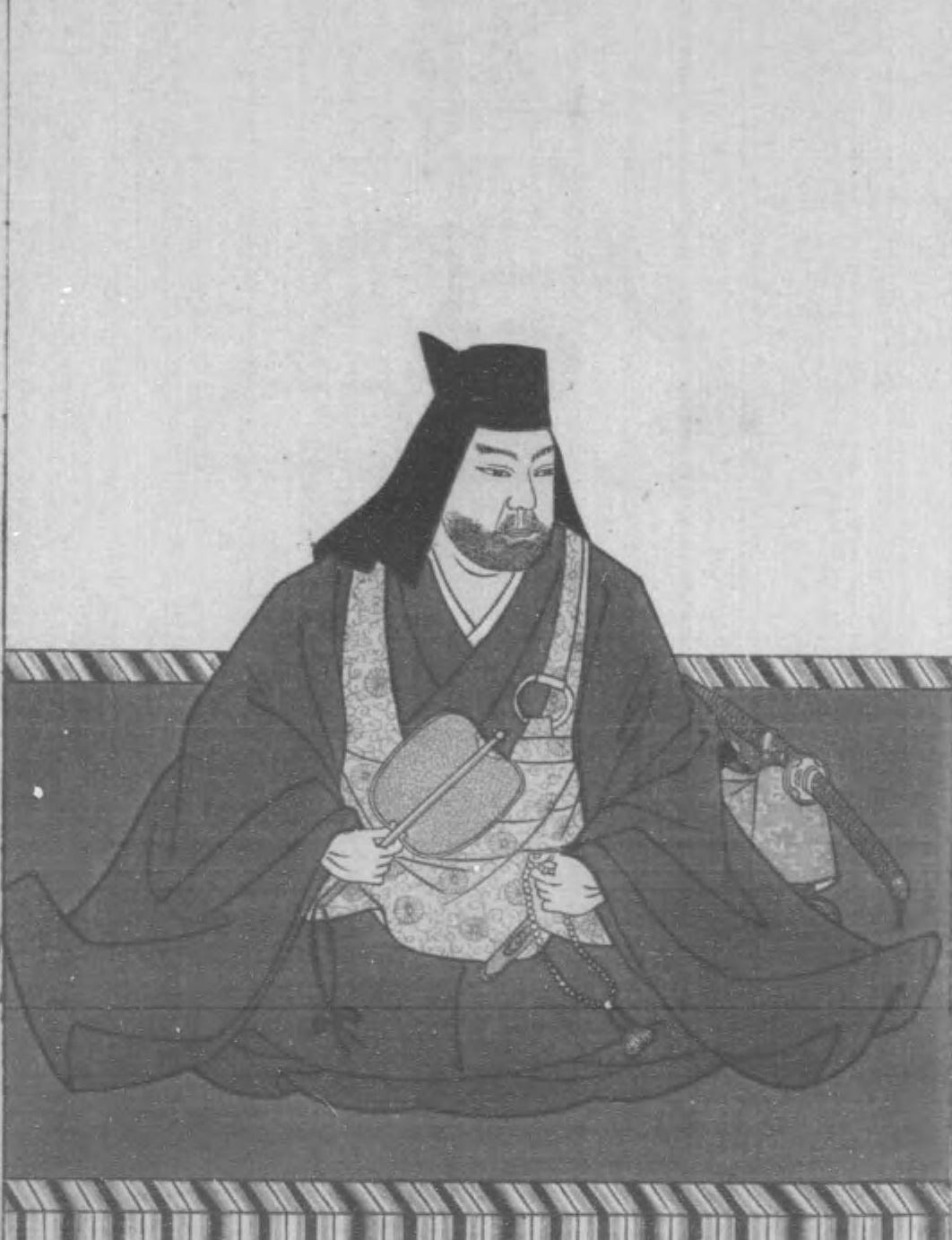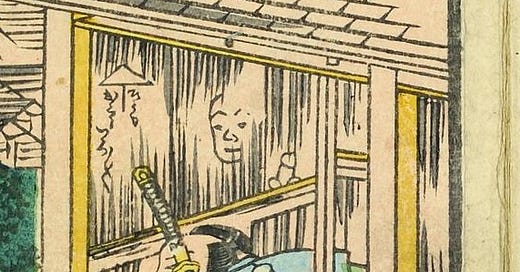
If you’re even remotely familiar with ‘ninja’ lore in English, you’ll have come across the story of death of the legendary warlord Uesugi Kenshin (1530-1578).1 Supposedly, Kenshin was assassinated by a shinobi who hid under his toilet and stabbed him in the anus when Kenshin went to answer the call of nature. This may be one of the most famous postwar ‘ninja’ stories of all, at least in English-speaking circles. It’s easy to find examples of it being retold in various corners of the internet (with varying degrees of seriousness), and it’s mentioned in almost all of the English-language literature on the ‘ninja,’ though again, authors vary in terms of how seriously they take it.2
This is such an incredible story - in the literal sense of ‘difficult to believe’ - that few people really lean on it as a genuine case of real-world shinobi activity. It’s still worth examining in detail, though, because it’s an interesting case study as to how ‘ninja’ tales originate and circulate, in English at least, and it also illustrates how ‘ninja’ historians happily re-circulate incredible claims about ‘ninja’ without any idea where the stories might come from. In contrast to the majority of ‘ninja’ historians, I actually do have a pretty solid idea of where the ‘toilet ninja’ story came from and how it spread, so that’ll be the main focus for today’s post. In the next post we’ll consider whether there’s any grounds for taking the story even the least bit seriously, then finally look at how ‘ninja’ historians have dealt with the story over the years.
Uesugi Kenshin, ‘Dragon of Echigo’

Uesugi Kenshin, then, was one of the most powerful daimyo, or feudal lords, of Japan’s Warring States era (1467-1603). Rising to power from Echigo Province in the north-central coastal area of Japan, he would go on to conquer almost all of the northern coast, roughly the area covered by modern-day Fukui, Ishikawa, Toyama, and Niigata Prefectures. At various times he also controlled territory further south and east, pushing into Shinano (modern-day Nagano, roughly) and Kōzuke Provinces (the western part of the Kantō plain, more or less).
Kenshin was a very successful leader of men, and, at least according to the war tales that depict him, a ferocious warrior himself, utterly unafraid of physical danger. Nihon gaishi (‘An Unofficial History of Japan’), a widely-read 19th century historical chronicle I’m currently translating, describes him as swift and fierce, but also rather impetuous; on one occasion, Kenshin was defeated because he was too aggressive and the besieged defenders were able simply to wait until his supplies ran out.3 Nevertheless, he seems to have been feared and respected by all of his neighboring domains; it’s often recorded in a number of historical chronicles that Oda Nobunaga, the first of the great unifying warlords of the Warring States period, was extremely cautious and respectful in dealing with Kenshin, fully aware that he could not defeat him on the battlefield, and was only able to conquer central Japan after Kenshin himself had died.4
Above all, though, Kenshin is famous for his rivalry with his neighboring warlord Takeda Shingen (1521-1573).5 Shingen, whose power base was in Kai Province (roughly modern Yamanashi), had similar territorial ambitions to Kenshin, and the two met in battle on numerous occasions. Japanese war chronicles (which are, I should stress, heavily romanticized) are full of examples of a shared sense of honor and respect between the two men, even though they were deadly rivals. On one occasion, for instance, other warlords conspired to cut off the supply of salt to Shingen’s land-locked domains. This was a problem, because salt was essential for the preservation of food, but Kenshin, damning the other warlords as cowards for this act, offered to supply Shingen with salt from his domains instead, observing that their rivalry was one of the battlefield, not of kitchen products.6
For all their military prowess, though, neither Kenshin nor Shingen would meet their death on the battlefield. Shingen would die first, passing away from illness five years before Kenshin in 1573.7 It’s recorded that instead of celebrating the demise of his great rival, Kenshin instead threw down his chopsticks and wept at the loss of such a fine warrior.8 Kenshin would follow Shingen into death five years later in 1578, also from illness…or so it would seem.
The ‘Dwarf Ninja’ Ukifune Jinnai
And so we come to the ‘toilet ninja’ story itself. The version of the story I’ll give here comes from Donn Draeger and Robert Smith’s Asian Fighting Arts, first published in 1969. I’m going with this because it’s probably the earliest sighting of the story for mainstream English-language readers:9
The clever Oda, taking no chances, had dispatched a dwarf ninja, Ukifune Jinnai, weeks in advance to study and make special preparations to assassinate his rival Kenshin. Ukifune, who stood no more than three feet tall, concealed himself in the lower recesses of the Kenshin private lavatory on the day of the entry of the other Oda ninja. He clung perilously and at great personal discomfort to the unsanitary under-structure by a technique perfected by him known as tsuchigumo [literally, ‘earth-spider’]. Ukifune was accustomed to cramped living: it is said that in the training camp he resided in a huge earthenware jar to prepare himself for such a situation. As Kenshin squatted in observance of his daily habit, Ukifune stabbed him with a spear that entered Kenshin’s anus and continued through his body until it protruded from his mouth. The screams of agony brought Kenshin’s ninja to the scene. But, when [Kenshin’s ninja master] Danjō and the others arrived, Kenshin was dead, and his assassin was nowhere to be seen. Ukifune had dived under the reservoir of fecal matter where he remained motionless, breathing through a tube, until Danjō and his ninja left with the lifeless body of their master. Then he quietly slipped out of the lavatory and the castle to report his deed to Oda.
So…yeah. This is quite the story, isn’t it? Sort of Slumdog Millionaire meets Grosse Pointe Blank.
The key question, though, would be where Draeger got the story. As usual, there’s no source cited - Draeger pretty much never cited his sources directly, and Asian Fighting Arts’ bibliography for Japanese topics is vague to the point of uselessness, noting only that “the best sources were the unpublished writings of Fujita Seiko” and various other authors.10 But Draeger’s direct source can nevertheless be identified as being a work we’ve mentioned previously in these pages, the children’s book Ninja and Ninja Skills Illustrated by the martial arts instructor and flamboyant self-publicist Hatsumi Masaaki, who had taught Draeger his version of ninjutsu.11
Draeger seems to have had basically no critical filter when it came to ‘ninja’ stories, and it doesn’t seem to have occurred to him to try to verify the original source for the story, or even consider that a children’s book might not be the most reliable source on which to base historical claims. Draeger would go on to include the ‘toilet ninja’ story in his book Ninjutsu two years later, and since Ninjutsu would remain in print for more than forty years, it was probably this later work that brought the story to the attention of most English-speaking readers.12 That Draeger was using Hatsumi’s children’s book is not really in dispute, since we know he used it as a source for a lot of other stories, and Draeger’s version of the story is almost word-for-word from Hatsumi’s, including the name Ukifune Jinnai, the claim that Jinnai was a dwarf, and the incredibly Freudian detail that the spear went through Kenshin’s anus and out through his mouth.
The next question, then, would be - where did Hatsumi himself get the story?
Kashiwazaki Monotagari - Tales of an Edo Rōnin
As you might expect, Hatsumi pretty much never cites his sources either (are you spotting a pattern here?), and given the extremely high prevalence of unsupported historical claims among Hatsumi’s writings, it might be tempting to think that he simply made the whole story up. This is not the case, however, as the story does appear in at least one premodern source, and had been noted by Japanese historians before the ‘ninja’ boom of the 1960s or the appearance of Hatsumi’s children’s book.
The earliest written mention of the ‘toilet ninja’ story I have been able to find is in a collection entitled Kashiwazaki’s Tales (Kashiwazaki monogatari), compiled in 1787.13 Kashiwazaki’s Tales is a collection of stories related by a rōnin (masterless samurai) named Kashiwazaki Saburōemon (dates unknown) to to a bannerman of the Tokugawa Shogunate named Nose Ichibei (dates also unknown), who wrote them down. The original copy was apparently difficult to read (maybe Nose had bad handwriting?) and so was re-copied in 1787 by a fairly high-ranking samurai named Mitsuhashi Narimichi (1751-1838). This latter is the text we have today.14
As far as I know Kashiwazaki’s Tales is only available in its original manuscript (i.e., hand-written) form, which is probably why it isn’t more generally known - not everyone can read hand-written documents, so historical texts are usually converted to printed form for general audiences in Japan. Fortunately, the text has been scanned and is publicly available from the Japanese National Archives, so I was able to get hold of it. Now, as I’ve noted before, my ability to read hand-written Japanese texts isn’t great, but it’s not non-existent, so I was able to track down the passage in question:

Transcribed and translated, the text in question reads:
On the eleventh day of the third month [of 1578], Kenshin suffered a stroke in the toilet. It is said that there was an intruder (shinobi no mono) under the floor who gouged Kenshin in the anus. Outwardly it appeared to be a stroke.
三月十一日謙信厠にて卒中風、床の下に忍の者有し肛門をくりぬきたると也。表向き卒中風也。
I’ve noted previously that it’s fairly rare for ‘ninja’ stories to be complete fabrications; there usually is at least some premodern source somewhere in the mix, though it’s often an unreliable or fictional source and often heavily embellished in the modern re-telling. So there actually is a premodern record of a story about Kenshin getting stabbed in the butt, and even better, it does indeed use the phrase shinobi no mono. But as always, we need to read our sources critically; we can’t just jump on Kashiwazaki’s Tales to consider the modern story proven.
For one thing, as I’ve argued previously, shinobi no mono does not translate automatically to the modern ‘ninja’; we can’t conclude that the term was meant to mean a skilled and trained assassin, since it probably just meant anyone who sneaked in somewhere (which is why I translated the term as ‘intruder’). For another, as you’ll have noted, several details in Hatsumi’s story aren’t in Kashiwazaki’s Tales, such as the assassin’s name being Ukifune Jinnai, the spear going out Kenshin’s mouth, or the idea that the assassin was a dwarf who trained by cramming himself into a jar. As far as I can tell, these latter points appear to be Hatsumi’s own 1960s embellishments.15
What Lies Beneath
It does seem, too, that at least some Japanese historians were aware of the ‘toilet ninja’ story before the ‘ninja’ boom of the 1960s. The prewar Japanese Kenshin scholar Fuse Hideharu (1875-1948) appears to have come across it, since he mentions it in his 1917 book A Biography of Uesugi Kenshin (Uesugi Kenshin-den):
There are any number of erroneous stories concerning the cause of Kenshin’s death, but the most frequently-told one would be that he was taken in by Oda Nobunaga’s deceptions and died at the murderous hand of Nobunaga’s assassin, being stabbed in the toilet. There are a great number of other extremely strained theories, but none of them are worth taking seriously.16
Even without Hatsumi’s modern additions, the ‘toilet ninja’ story is a weird and implausible one on its face, so I don’t think we could blame Fuse for declaring that it was not to be taken seriously. I share his view - I think there’s no chance whatsoever that it actually happened - but I’m not necessarily going to dismiss the story out of hand. I’d rather give it a fair trial, so to speak, to take a look at some of the historical evidence surrounding Kenshin’s death and to consider even the remote possibility that there might be something to the story.
So, that’s what we’ll do in the next post.
Uesugi Kenshin 上杉謙信.
See e.g. Donn Draeger, Ninjutsu (1971, my copy 1989), pp. 111-113; Stephen Turnbull’s 1991 Secret Warrior Cult, pp. 54-55 and 2003 Ninja: AD 1460-1650, pp. 32 and 41; Zoughari, The Ninja: Ancient Shadow Warriors (2010), pp. 51-52; Thomas Lockley, African Samurai: The True Story of Yasuke, A Legendary Black Warrior in Feudal Japan (2019), p. 163; and probably loads of other venues as well.
This happened when Kenshin laid siege to the Later Hōjō’s Odawara Castle in 1560. See Nihon gaishi kōgi 日本外史講義 (Kōbunsha, 1914), 2:452.
Nihon gaishi kōgi 3:42.
Takeda Shingen 武田信玄.
Nihon gaishi kōgi 3:44.
There are also accounts of Shingen’s death that suggest his death resulted from a wound sustained from a sniper’s bullet during the siege of Noda Castle earlier in 1573.
Nihon gaishi kōgi 3:54.
I say “probably” because Turnbull has claimed that the story may have appeared in a French- and English-language martial arts journal in the early 1950s (Secret Warrior Cult, p. 54). I think this is probably Budo Magazine Europe (known earlier as Judo Kodokan or Judo Kodokan Review), which was published in both French and English. Unfortunately issues of this journal are very difficult to locate - none of the libraries or repositories I’ve surveyed have all of the issues from the early 1950s - so I cannot yet confirm this. It seems pretty clear that Draeger was mostly responsible for the story’s spread in English, anyway.
Draeger and Smith, Asian Fighting Arts (Kōdansha, 1969), p. 193.
Hatsumi, Shōnen no tame no ninja, ninpō gahō (Akiyama shoten, first pub. 1964), p. 137. Unfortunately (or fortunately, maybe) there is no accompanying illustration. Also, the kanji used for Ukifune Jinnai are 浮舟甚内. You’re welcome, Reddit commenter SillyRookie!
Draeger, Ninjutsu, pp. 111-113. As far as I can tell Draeger never acknowledged in print that Hatsumi’s children’s book was the source for a lot of his information.
Kashiwazaki monogatari 柏崎物語.
Kashiwazaki Saburōemon 柏崎三郎衛門; Nose Ichibei 能勢市兵衛; Mitsuhashi Narimichi 三橋成方. Details from Kokushi daijiten, '“Kashiwazaki monogatari,” accessed through Japan Knowledge.
To give due credit here, John Man identifies the source for the ‘toilet ninja’ story as being Kashiwazaki’s Tales in his 2013 Ninja: 1000 Years of the Shadow Warrior: A New History, p. 118. This information he apparently got from Minami Yoshie, translator of BSSK. Man does allude to Hatsumi’s children’s book (p. 117), but doesn’t specifically identify it, describing it only as “[t]he source on which Draeger and Smith relied” and seemingly assuming that Draeger and Smith added the embellishments, rather than Hatsumi, as appears to be the case.
Fuse Hideharu 布施秀治, Uesugi Kenshin-den 上杉謙信伝 (Kenshin Bunko, 1917), p. 531. Japanese (viewable here): 謙信の死因につきては、謬伝紛々たり。最も人口に膾炙するところのものは、信長の譎計に陥り、其刺客の兇手に罹りて、厠中に刺さると。その他牽強付会甚だ多しと雖も、みな採るに足らず […].
This source is mentioned by Turnbull in his 1991 Secret Warrior Cult (bibliography, p. 154) but for reasons I can’t figure out he describes it as being by an anonymous author and the year of publication as being unknown. I have no idea what copy of the text he was using that didn’t contain either the author’s name or the publication date.



